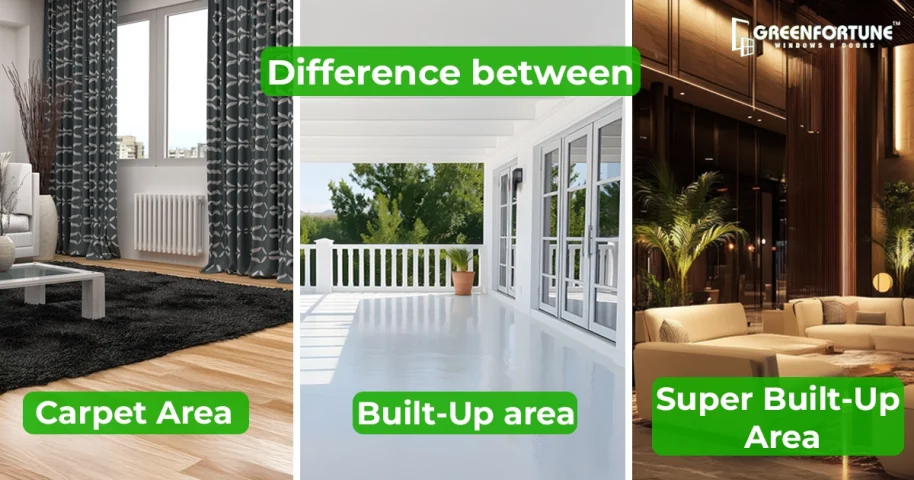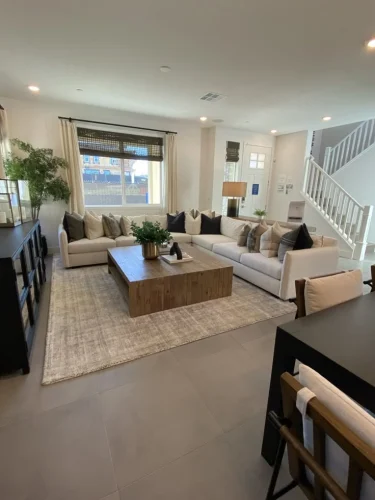
Distemper vs Emulsion: Choosing the Right Paint for Your Walls
April 9, 2025
Kitchen Laminates Design: Stylish and Functional Ideas for Your Cooking Space
April 9, 2025Buying a house is a big deal, a dream come true. But, real estate can be confusing with all its terms. Understanding terms like carpet area vs built-up area vs super built-up area is really important, but often people don't understand them. Knowing the difference helps you make a smart choice and get the right amount of space for your money.
Table of contents
- What is Carpet Area vs Built-Up Area vs Super Built-Up Area
- Key Differences b/w Carpet Area vs Built-Up Area vs Super Built-Up Area
- Why do These Measurements Matter in Real Estate Deals?
- How Developers Calculate These Areas
- Tips/ Suggestions for Buyers
- Conclusion
- Green Fortune Doors & Windows
- Frequently Asked Questions (FAQs)
What is Carpet Area vs Built-Up Area vs Super Built-Up Area
Source: Pinterest
- Built-Up Area: Built-up area is the space you can walk on inside your home, plus the space taken up by all the walls. It also includes balconies and terraces and in some cases, it can even include parts of common areas like staircases and elevators.
- Carpet Area: The carpet area is the actual usable floor space within the walls of your house. It excludes the thickness of the inner walls.
- Super Built-Up Area: It includes the built-up area plus a proportionate share of common areas like lobbies, staircases, lifts, clubhouses, and sometimes even gardens and swimming pools. Builders often use this area for quoting prices.
Key Differences b/w Carpet Area vs Built-Up Area vs Super Built-Up Area
If you want to know the difference between carpet area and built-up area. Then imagine you're buying an apartment advertised as 1200 square feet. But this 1200 square feet is a super built-up area.
In this super build-up area, the actual built-up area will be around 1000 square feet. Then comes the actual carpet area, the space you'll live in, and this could be as low as 800 square feet.
This demonstrates the significant discrepancy between the advertised area and the usable space. The difference arises due to the inclusion of walls and common areas in the calculations.
Why do These Measurements Matter in Real Estate Deals?
Source: Pinterest
If you are considering buying a new house or apartment then you need to understand these measurements.
- The builders might mislead you by telling you the super build-up area instead of the carpet area. So it's important to know the difference between the two.
- Understanding the differences helps you negotiate a fair price. Builders often quote the prices based on the super built-up area, which may not reflect the actual usable space. If you know the difference between the terms like carpet area vs built-up area then you can prevent disputes and you get what you expect.
- Knowing the exact carpet vs build-up area enables you to plan your interiors and furniture layout efficiently and prevent wastage of material and money.
How Developers Calculate These Areas
Developers/ Builders use different methods to calculate these areas, often relying on architectural plans and building regulations.
- Super Built-Up Area: Developers use a "loading factor" to calculate this. The loading factor is a percentage added to the built-up area to account for common areas. This factor can vary significantly between projects and developers.
- Built-Up Area: This involves adding the wall thickness to the carpet area. The calculation may vary depending on the inclusion of balconies and terraces.
- Carpet Area: This is calculated by measuring the internal dimensions of the apartment and subtracting the wall thickness.
Tips/ Suggestions for Buyers
- Before buying any property ask your builder to clearly define what is included in each measurement.
- Ask for detailed floor plans that indicate the carpet area vs built-up area, and super built-up area.
- Ask about the loading factor used to calculate the super built-up area. A high loading factor means you're paying for a larger share of common areas.
- Physically visit the property to get a sense of the actual space. Don't rely solely on the advertised area.
- Seek advice from a trusted real estate agent or consultant who can help you navigate these complexities.
- Don't take any verbal agreements, make sure every measurement is written into the sales agreement.
- Learn your local Real Estate Regulatory Authority (RERA) rules.
Also Read: Window Frame Dimensions: A Complete Guide For Homeowners
Conclusion
In the complex world of real estate, understanding the distinctions between carpet area vs built-up area, and super built-up area is crucial. By equipping yourself with this knowledge, you can navigate property transactions with confidence, ensuring you secure a home that truly meets your needs and expectations.
Green Fortune Doors & Windows
At Green Fortune Doors and Windows, we prioritize the creation of eco-conscious, top-tier home enhancements. We specialize in producing and implementing power-saving doors and window systems that lessen ecological strain and boost domestic efficiency. Opting for Green Fortune means selecting enduring, visually appealing products that bolster a sustainable living approach, merging home upgrades with environmental stewardship.
Also Read: Top 5 Bathroom Glass Door Ideas
Frequently Asked Questions (FAQs)
Q1: What is the difference between Carpet area vs built-up area?
A: The built-up area includes the carpet area plus the area occupied by the walls, balconies, and terraces. But the carpet area is the actual floor space within the walls of your house excluding the thickness of the inner walls.
Q2. How to calculate the actual carpet area of an apartment?
A: There are many ways to calculate the actual carpet area of an apartment. But, the best way is to ask for a detailed floor plan from your builder. You can also physically measure the internal dimensions of the apartment and subtract the wall thickness.
Q3. Is the terrace included in the carpet area?
A: No, the terrace is not included in the carpet area. But is included in the build-up area covers the carpet area plus the area of walls, balconies, terraces, and other extensions.









